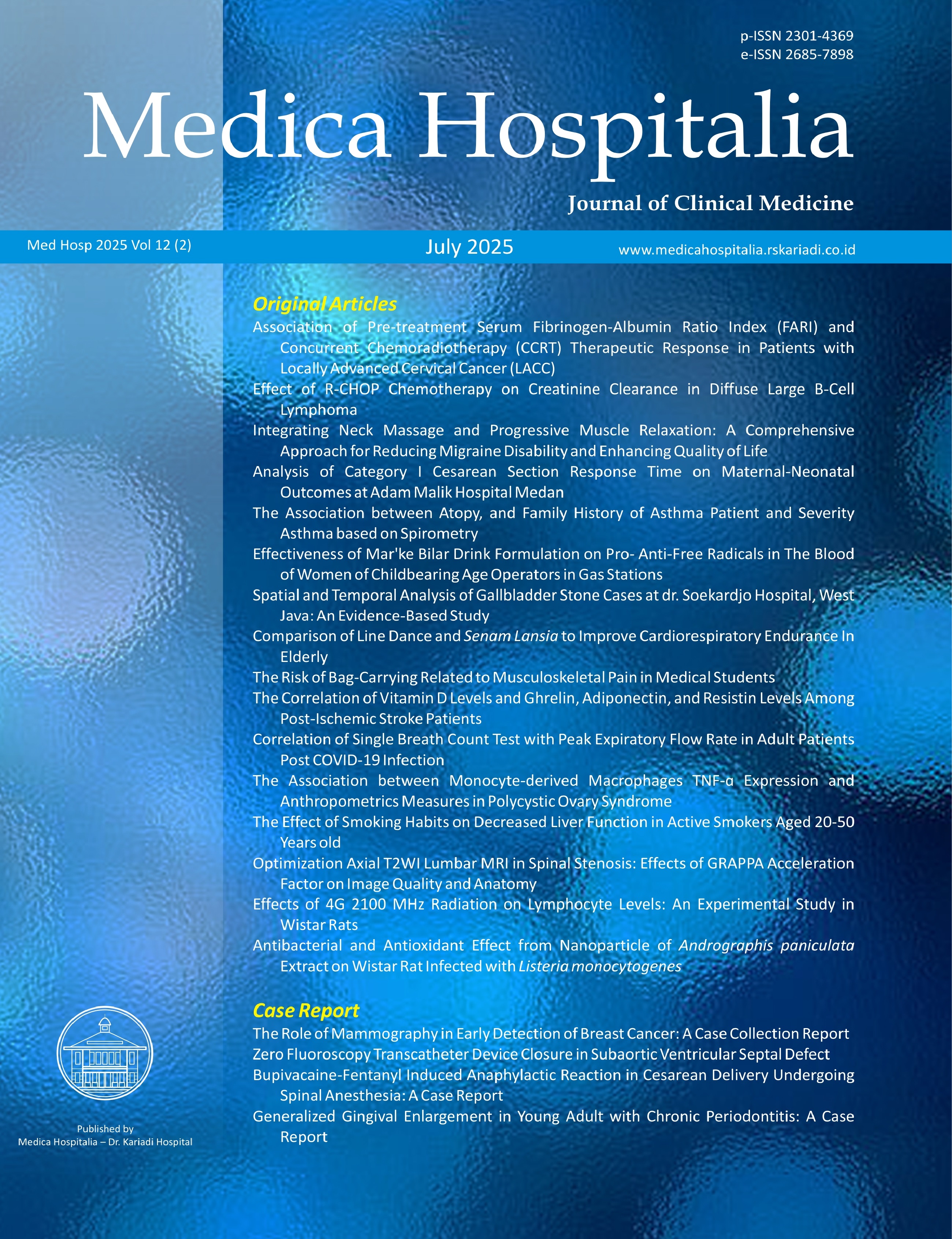Analysis of Category I Cesarean Section Response Time on Maternal-Neonatal Outcomes at Adam Malik Hospital Medan
DOI:
https://doi.org/10.36408/mhjcm.v12i2.1217Keywords:
Emergency caesarean section, Decision to incision interval, Response time, Maternal Mortality rate, Neonatal mortality rate, MedanAbstract
BACKGROUND: Maternal and neonatal mortality remain significant global health concerns. Category I cesarean sections are performed in life-threatening obstetric emergencies, with a recommended decision-to-incision interval (DII) of ≤30 minutes.
AIMS: To evaluate the proportion of category I emergency cesarean sections performed < 30-minute response time at Adam Malik Hospital, Medan, and to identify factors contributing to delays.
METHODS: This retrospective cohort study included 44 consecutively selected cases of category I emergency cesarean sections performed at Adam Malik Hospital, Medan, between January 1 and December 31, 2023. Eligible cases involved immediate threats to maternal or fetal life and had complete documentation of surgical timings. Time data including decision-to-incision interval and its components were extracted from electronic medical records and cross-validated with operating room and delivery ward logs. The primary outcome was decision-to-incision interval (DII), dichotomized at 30 minutes. Variables associated with DII (p <0.25) were included in multivariate analysis using Firth’s penalized logistic regression to account for small sample size and data separation.
RESULTS: Only 43.2% of cases achieved a DII of ≤30 minutes. Multivariable analysis identified patient transfer time (AOR = 16.91, 95% CI: 2.19–358.36) and anesthesia duration (AOR = 27.21, 95% CI: 2.29–889.18) as significant predictors of delay. No significant associations were found between DII and adverse maternal or neonatal outcomes.
CONCLUSION: Delays in patient transfer and anesthesia were the main contributors to prolonged DII in emergency cesarean sections. While these delays did not significantly impact short-term clinical outcomes, targeted improvements in emergency obstetric workflows may help hospitals meet national response time standards and enhance quality of care.
Downloads
References
1. Shahid Ali S. Maternal Mortality Rate. Vol. 02, Journal of Pregnancy and Child Health. 2015 [cited 2024 Apr 24]. Available from: https://www.who.int/news-room/fact-sheets/detail/maternal-mortality
2. Badan Pusat Statistik. Profil Kesehatan Ibu dan Anak 2022. Badan Pusat Statistik. 2022
3. United Nation Population Funds UNFPA. Strengthening Data to Reduce Maternal Deaths in Indonesia. 2023 [cited 2024 Apr 24]. Available from: https://indonesia.unfpa.org/en/news/strengthening-data-reduce-maternal-deaths-indonesia
4. Badan Pusat Statistik. Sensus Penduduk 2020. BpsGoId. 2023;(27):1–52. Available from: https://papua.bps.go.id/pressrelease/2018/05/07/336/indeks-pembangunan-manusia-provinsi-papua-tahun-2017.html
5. Kementrian Kesehatan RI. Kemenkes Perkuat Upaya Penyelamatan Ibu dan Bayi – Sehat Negeriku. 2021 [cited 2024 Apr 24]. Available from: https://sehatnegeriku.kemkes.go.id/baca/umum/20210914/3738491/kemenkes-perkuat-upaya-penyelamatan-ibu-dan-bayi/
6. Badan Pusat Statistik Indonesia. Sensus Penduduk 2020 - Indonesia. 2023;(09):1–44. Available from: http://sp2010.bps.go.id/
7. National Institute for Health and Care Excellence (NICE). Caesarean birth (NG192). 2021. Available from: www.nice.org.uk/guidance/ng192
8. Kementrian Kesehatan RI. Peraturan Menteri Kesehatan Republik Indonesia Nomor 30 Tahun 2022 Tentang Indikator Mutu Pelayanan Kesehatan. Indonesia; 2022. Available from: www.peraturan.go.id
9. Pengurus Pusat Perkumpulan Obstetri dan Ginekologi Indonesia (POGI). Panduan Klinis Seksio Sesarea. Jakarta; 2022
10. Andisha E, Cronjé L. Evaluating the decision-to-delivery interval in category 1 emergency caesarean sections at a tertiary referral hospital. S Afr J Obstet Gynaecol. 2019;25(3):95–9
11. Dorjey Y, Tshomo Y, Wangchuk D, Bhandari P, Dorji C, Pradhan D, et al. Evaluation of decision to delivery interval and its effect on feto-maternal outcomes in Category-I emergency cesarean section deliveries in Phuentsholing General Hospital, 2020: A retrospective cross-sectional study. Health Sci Rep. 2023;6(1):1–11.
12. Wangwe P, Kibwana M, August F, Kikula AI. Decision to delivery interval, maternal and fetal outcomes in emergency caesarean sections in a tertiary teaching hospital, Dar es salaam, Tanzania. Afr Health Sci. 2023;23(3):17–26
13. Dur-e-Shahwar, Ahmed I, Amerjee A, Hoodbhoy Z. Comparison of neonatal outcomes between category-1 & non-category-1 primary emergency cesarean section: A retrospective record review in a tertiary care hospital. Pak J Med Sci. 2018;34(4):823–7
14. Dunn CN, Zhang Q, Sia JT, Assam PN, Tagore S, Sng BL. Evaluation of timings and outcomes in category one caesarean sections: A retrospective cohort study. Indian J Anaesth. 2016;60(8):546–51.
15. Kitaw TM, Limenh SK, Chekole FA, Getie SA, Gemeda BN, Engda AS. Decision to delivery interval and associated factors for emergency cesarean section: a cross-sectional study. BMC Pregnancy Childbirth. 2021;21(1):1–7
16. Yeni CM, Hasanuddin H, Maharani CR, Maulida NF. Evaluasi Response Time Seksio Emergensi Kategori I Terhadap Luaran Maternal dan Neonatal Dengan Tersedianya Alur Pelayanan Seksio Sesarea Emergensi Di RSUDZA Juli-Oktober 2021. J Med Sci. 2022;3(1):10–8
17. Gunawan T, Attamimi A, Pradjatmo H. Hubungan Response Time Seksio Sesarea Emergensi Kategori 1 dengan Luaran Perinatal di RSUP Dr.Sardjito. Jurnal Kesehatan Reproduksi. 2018;5(1):60
18. Tebeu PM, Tchamte CN, Kamgaing N, Antaon JSS, Mawamba YN. Determinants of the decision to incision interval in case of emergency caesarean section in Yaoundé’ hospitals. Afr Health Sci. 2022;22(2):511–7
19. Temesgen MM, Gebregzi AH, Kasahun HG, Ahmed SA, Woldegerima YB. Evaluation of decision to delivery time interval and its effect on feto-maternal outcomes and associated factors in category-1 emergency caesarean section deliveries: Prospective cohort study. BMC Pregnancy Childbirth. 2020;20(1):1–11.
20. Chow KM, Mak SL. Maternal and Fetal Outcomes in Extremely Urgent Caesarean Delivery in Relation to the Decision-to-delivery Interval. Hong Kong J Gynaecol Obstet Midwifery. 2015;15(1):16–22.
21. Maducolil MK, Ajmal S, Alzebdeh EA, Abdel Rahim AY, Ali Rudwan EM, Joel S, et al. Category 1 cesarean section decision to delivery interval: the causes of delay and impact on neonatal outcomes. International Journal of Pregnancy & Child Birth. 2021;7(4):98–104.
22. Grace L, Greer RM, Kumar S. Perinatal consequences of a category 1 caesarean section at term. BMJ Open. 2015;5(7):1–6
23. K Radhika, E Gomathy. A prospective observational study on decision to delivery interval and perinatal outcome in emergency caesarean section in tertiary care hospital. International Journal of Clinical Obstetrics and Gynaecology. 2021;5(1):19–25
Additional Files
Published
How to Cite
Issue
Section
Citation Check
License
Copyright (c) 2025 Mohammad Naufal, Sarma Nursani Lumbanraja, Iman Helmi Effendi, Edwin Martin Asroel, Hanudse Hartono, Sarah Dina (Author)

This work is licensed under a Creative Commons Attribution-ShareAlike 4.0 International License.
Copyrights Notice
Copyrights:
Researchers publishing manuscrips at Medica Hospitalis: Journal of Clinical Medicine agree with regulations as follow:
Copyrights of each article belong to researchers, and it is likewise the patent rights
Researchers admit that Medica Hospitalia: Journal of Clinical Medicine has the right of first publication
Researchers may submit manuscripts separately, manage non exclusive distribution of published manuscripts into other versions (such as: being sent to researchers’ institutional repository, publication in the books, etc), admitting that manuscripts have been firstly published at Medica Hospitalia: Journal of Clinical Medicine
License:
Medica Hospitalia: Journal of Clinical Medicine is disseminated based on provisions of Creative Common Attribution-Share Alike 4.0 Internasional It allows individuals to duplicate and disseminate manuscripts in any formats, to alter, compose and make derivatives of manuscripts for any purpose. You are not allowed to use manuscripts for commercial purposes. You should properly acknowledge, reference links, and state that alterations have been made. You can do so in proper ways, but it does not hint that the licensors support you or your usage.
























